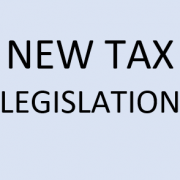Writing about the new tax legislation in your client letters
If you’re an investment or wealth manager, you and your clients will be affected by the tax legislation signed by President Trump on December 22, 2017. You probably need to mention the legislation in your quarterly client letter or commentary. I think the language that you use to refer to the legislation will be important.
Your choices for how to refer to the tax law fall into three categories, as I see it.
- Neutral—tax legislation, tax bill, tax law, or the law’s formal name, which was originally the Tax Cuts and Jobs Act
- Positive—tax reform, tax cuts
- Negative—tax cuts for the rich
What advisors and writers recommend
When I asked about on social media about writers’ choices, respondents preferred neutral language. Their suggestions included using the tax legislation’s official name. Financial writer Lisa Plotnick said, “I refer to it by name for two reasons — to be neutral (as per my journalism training) and to make it easier for future readers to know the exact bill being referred to (the researcher in me).”
Most of my respondents seemed to believe, as I did, that the legislation’s formal name was the Tax Cuts and Jobs Act (TCJA). But one of my readers questioned that. I learned that the name “Tax Cuts and Jobs Act” violated the Senate’s Byrd Rule, according to CNN in “Senate rules force Republicans to go with lengthy name for tax plan.” As a result, said CNN, the bill got “stuck with the unwieldy name ‘To provide for reconciliation pursuant to titles II and V of the concurrent resolution on the budget for fiscal year 2018.’ ” Despite this, you still might be able to get away with referring to the “Tax Cuts and Jobs Act,” as the AICPA did in the Journal of Accountancy. That term is more likely to be recognized than “To provide for reconciliation pursuant to titles II and V of the concurrent resolution on the budget for fiscal year 2018.” Still, if you refer to the “Tax Cuts and Jobs Act,” people may not recognize that name. It’s safer to substitute something like “the tax legislation signed by President Trump on December 22, 2017.”
Another respondent said he refers to the Affordable Care Act instead of Obamacare, so he sees using TCJA as a comparable decision. The Affordable Care Act analogy raises the issue of the power of formal names to shape public perception. When talk show host Jimmy Kimmel had a crew interview people on the street about Affordable Care Act and Obamacare, people spoke much more favorably about the Affordable Care Act than Obamacare. This was true even though Obamacare is another name for the Affordable Care Act. Be aware of that when you use legislation’s formal name. Using the TCJA may not be as neutral as using a generic term.
Yet another respondent suggested that a firm’s compliance officer might flag your commentary if you use partisan language in discussing the legislation.
The risks and benefits to using positive or neutral language about the law
The risks stem from the fact that people feel strongly about the topic. If you seem to endorse or oppose the law, you may alienate readers.
On the other hand, if your clients and prospects are mainly in one camp or the other, partisan language may make your readers feel a deeper sense of connection with you. You sacrifice that opportunity, and perhaps lose authenticity, if you don’t use language that expresses your positive or negative views.
What newspapers do
As you may remember from “Financial jargon killer: The Wall Street Journal,” I suggest looking to newspapers for guidance on matters of writing style.
For example, a Wall Street Journal article published on Dec. 22 uses neutral language, but doesn’t use the law’s official name. It said, “President Donald Trump signed the 21% corporate tax rate into law Friday and Democrats are talking about which pieces of the bill they will keep and which they will toss aside should they assume power” (emphasis added).
In a quick scan of the Journal‘s website, the bill’s name seemed to appear more in opinion pieces and reports on the legislative process than in news articles. That may be because the name “Tax Cuts and Jobs Act” is more agreeable to Republicans than to Democrats. Or perhaps it’s to save space because, as I said above, you need to describe what the act is if you use its official name.
On the website of The New York Times, a Dec. 22 Reuters article didn’t use the legislation’s formal name. Instead, it initially referred to “the biggest overhaul of the U.S. tax code in 30 years.” However, later it used the positive term “tax reform” and referred to the “Tax Cuts and Jobs Act” in discussing Mallinckrodt’s filing discussing the legislation.
YOUR preference?
I’m curious. How will you refer to the tax legislation in your next client communication?
Dec. 28-29, 2018 update: I’ve edited this article to reflect the fact that the Tax Cuts and Jobs Act isn’t the formal name of the law, as I and others had originally assumed. I also added a link to the Journal of Accountancy, which was sticking with the Tax Cuts and Jobs Act in an article published on Dec. 22.




Susan, I was under the impression that there was no name… “Tax Cut and Jobs Act” got left on the cutting room floor due to rules around reconciliation.
I thought it was inaccurate to refer to it that way.
Andy, is there a place where I can go to check the final name?
I just looked at https://www.congress.gov/bill/115th-congress/house-bill/1, which refers to “H.R.1 – An Act to provide for reconciliation pursuant to titles II and V of the concurrent resolution on the budget for fiscal year 2018.” However, in the body of the text it refers to “Tax Cuts and Jobs Act.”
Andy, I did a bit more research and found this CNN article that agrees with you: http://www.cnn.com/2017/12/19/politics/tax-bill-name-delay/index.html
I will edit the text of my blog post.
Nice! I saw your revised copy.
And for the record, prefer Bernie’s options.?
So while the words, “To provide for reconciliation pursuant to titles II and V of the concurrent resolution
on the budget for fiscal year 2018.” are the very first words under “An Act”, the “Tax Cuts and Jobs Act” is mentioned multiple times in the new legislation and will make its way into Title 26 of the US Code.
Example of the sunset provision: “which is 10 years after the enactment of the Tac Cuts and Jobs Act.
Thanks, Joe, that’s interesting. This is complicated.